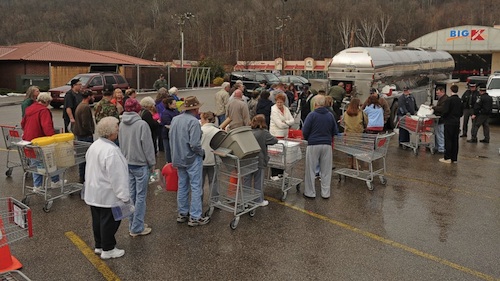You can find pretty good summaries all over the Internet (including here, here, and here), but the basic situation is this: a company called Freedom Industries — which actually works with water treatment chemicals — spilled 7,500 gallons of 4-methylcyclohexane methanol, or MCMH (which is used for washing coal) into the Elk River just upstream from where the regional water company has intake pipes. CDC (Center for Disease Control) needs the concentration of MCMH to be less than 1 part per 1 million for more than 24 hours in order to be safe for drinking/showering/anything except flushing the toilet, so that’s where about 300K residents stand right now: FEMA and others are involved in bringing bottled water to stores, but it could be another couple of days until all drinking water is restored.
Here’s the obligatory regulatory mess that should fire you up, via The New York Times:
According to Department of Environmental Protection officials, Freedom Industries, which owns the chemical tank that ruptured, is exempt from Department of Environmental Protection inspections and permitting since it stores chemicals, and does not produce them, The Associated Press reported. Gov. Earl Ray Tomblin said he would look into tighter regulation of chemical storage facilities. “There are certain reporting things that companies have to do,” he said. “And I do think we have to look at them to make sure this kind of incident does not happen again.”
If you’d like to know more about how water actually gets from source to your tap, this is a fairly detailed PDF from the EPA. I had absolutely no idea about a lot of it, including the fact that 195 million Americans drink off a surface water (lakes, rivers, reservoirs) system as opposed to just over 100K Americans off a ground water (aquifer) system, although 147K water systems have ground water (aquifer) as a source (compared to about 14K for surface water as a source).
Alright, so this all got me wondering — if a company in West Virginia can have a crack in a storage container, and a chemical can run-off into the water source and it takes long enough to notice that 300K people are affected for about six days … well, what’s protecting our water supply from greater threat? This certainly isn’t helpful:
In a recent security bulletin, DHS and the Interagency Threat Assessment and Coordination Group warned local water utilities of a simple tactic terrorists could use to introduce a chemical or biological agent into the water supply and spread it over long distances without immediate detection.
“Over the last decade, violent extremists have expressed aspirational interest in contaminating unspecified water supplies, and as recently as July 2011 specifically raised backpressure as a means of contamination,” the bulletin said.
Backpressure is basically public water flowing backwards because of pressure changes (logical name, no?). If you lose pressure in a public water system, too, anything in that current line will be siphoned back into the main water system — that’s where the 2011 terrorist idea comes into play. The good thing is, all fifty states use controlled cross-connections and backflow prevention systems. 32 states have “active backflow prevention systems.” And there’s also this:
Meanwhile if terrorists tried to use a biological agent, Dillard said the chlorine in tap water should be enough to nullify it.
“That’s what we keep the chlorine for, to keep the nasties out. It also keeps dysentery and cholera out of our water systems,” he said.
This is a much more detailed look at the threat, including this section:
PDD 63 established the National Infrastructure Protection Center (NIPC), and appointed the USEPA as lead federal agency on critical infrastructure protection issues for the water supply sector (National Security Council, 1998). USEPA subsequently appointed Diane VanDe Hei, executive director of the Association of Metropolitan Water Agencies (AMWA) as the water sector liaison to the federal government on critical infrastructure. USEPA is funding, in cooperation with the AWWA Research Foundation, a research project to develop a vulnerability assessment methodology. AMWA established a national Critical Infrastructure Protection Advisory Group (CIPAG), which began meeting in January 2001. Comprised of industry representatives, with technical support from water associations and federal agencies such as USEPA, FBI, and the Department of Energy, the CIPAG is providing guidance to a variety of activities.
That’s a lot of acronyms and bureaucracy, but at least people are focused on the issue.
The water supply system is considered one of 17 critical infrastructures for the United States (full list) and as such, is monitored fairly thoroughly. Now, America may be running out of water (uh, yep), but the idea of it being poisoned is apparently less so.

If you live in West Virginia, did you watch the news conference?